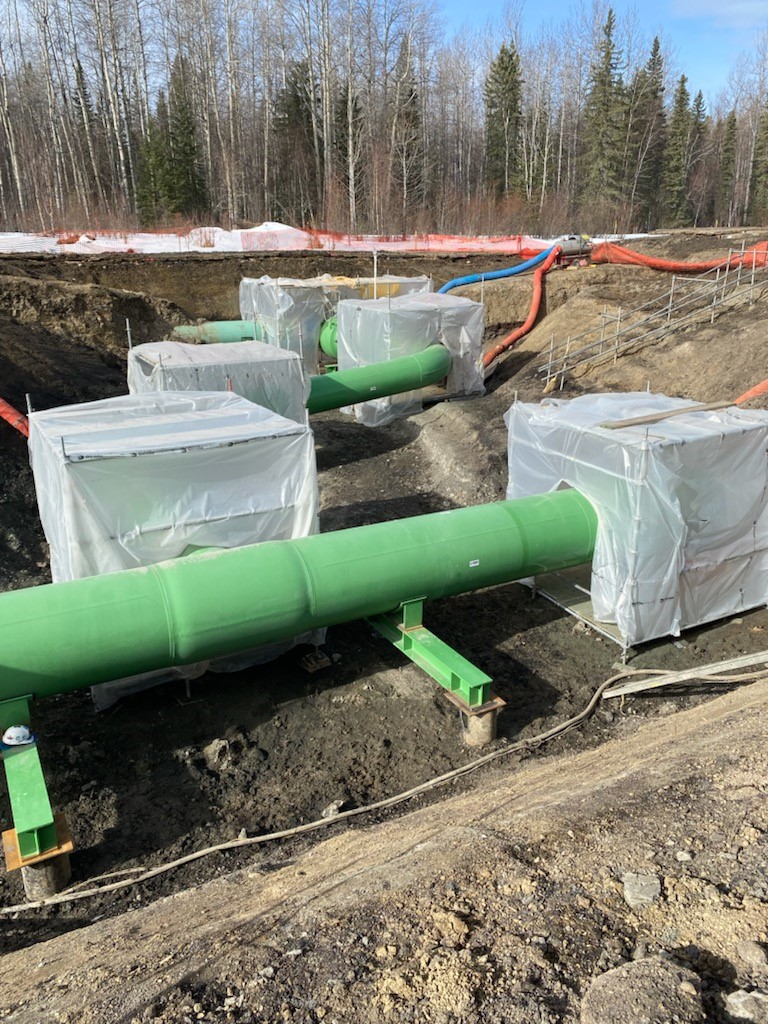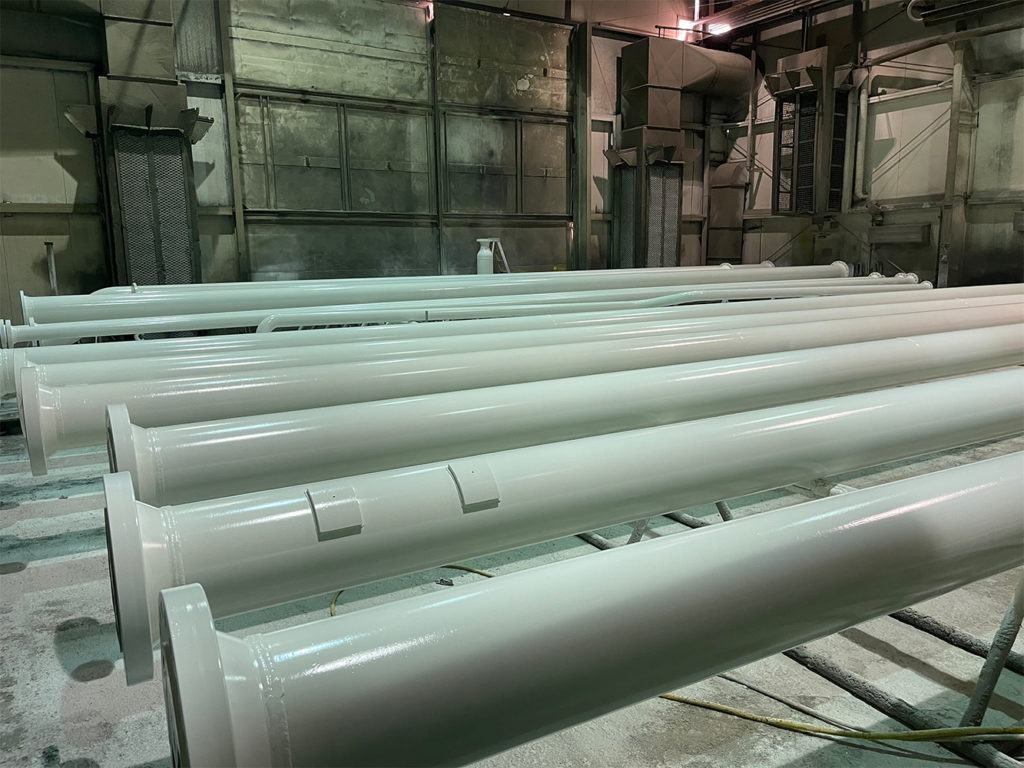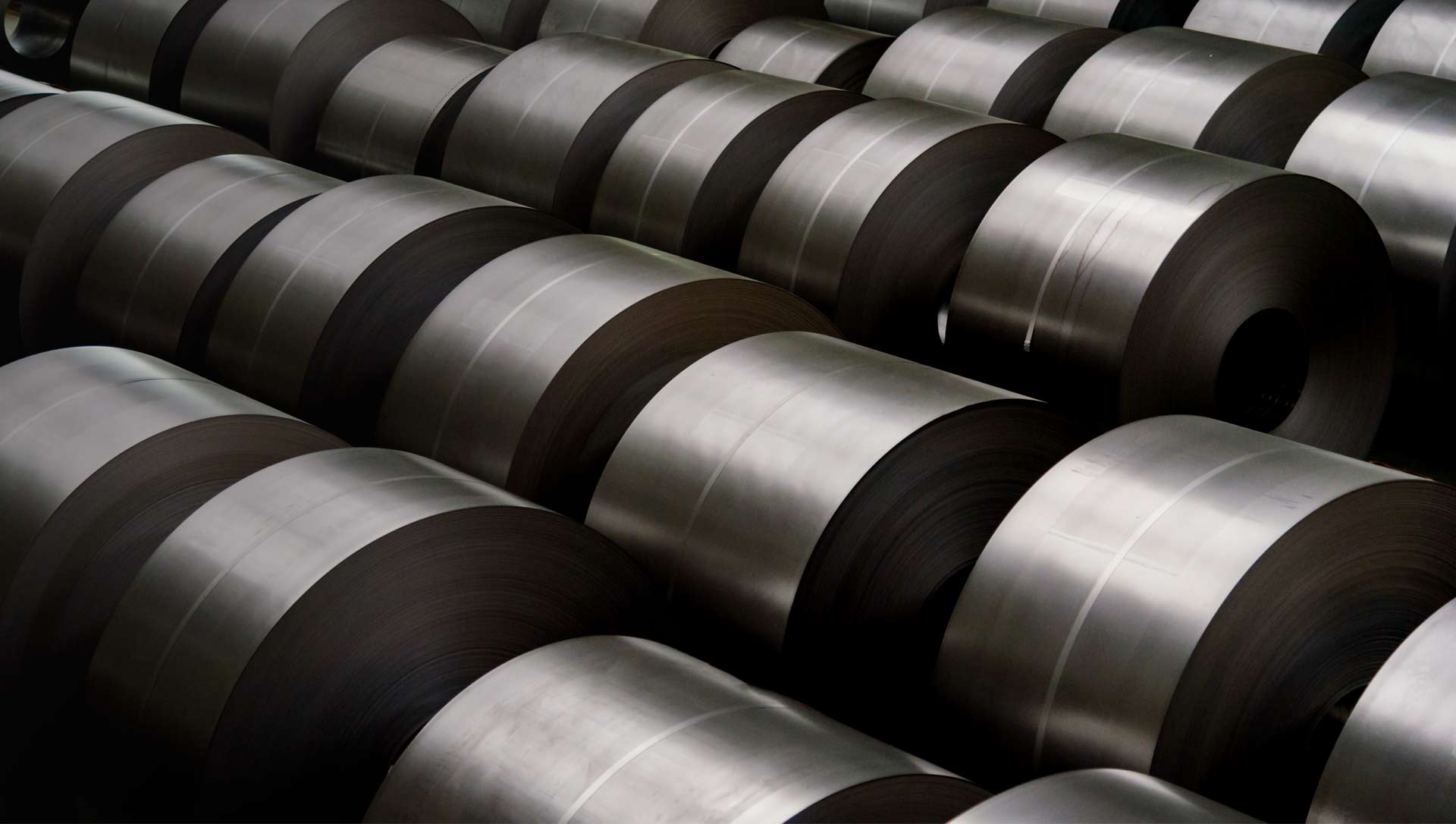Understanding Industrial Coatings
Paint is one of the most common ways to protect steel and pipe from corrosion. Over the years paints and coatings have improved to keep up with the demands from owners and regulators for durability and performance.
Application of industrial coatings or alternatively paints, are applied to metal through a multi-step process that usually consists of a primer, undercoat(s) and topcoats, each of which have a specific function.
Paints are created by combining three main components.

- Pigments – typically a fine ground inorganic or organic powder which provides color, opacity, film cohesion and may contain a corrosion inhibitor.
- Binder – usually a resin or oil, however, can also be inorganic compounds such as soluble silicates. The binder is the film forming component of the paint.
- Solvent – used to dissolve the binder and to facilitate the application of the paint. Solvents can be either an organic liquid or water.
Industrial coatings are applied to the metal services by several methods including by brush, roller, air or airless sprayer, and in all cases when applied create a “wet film.” Paint manufactures and Ideal’s client will have requirements for measurement of “wet film” which is a measurement of the thickness of the paint prior to the solvent evaporating. Once the solvent evaporates the binder and pigment are left behind on the surface of the metal and is called “dry film” The corrosion protection provided by the coating selected is directly proportional to the dry film thickness of the coating.
Industrial coatings systems are applied in multiple layers to the substrate (steel) following proper surface preparation. (To learn more about surface preparation see Ideal’s previous article “SSPC Explained”
Primers – are applied directly to the cleaned substrate steel services, with the purpose to wet the surface and to provide good adhesion for subsequently applied coats. Primers are a sacrificial or barrier coat and a first line of defense against corrosion. Zinc primers are an example of a sacrificial coat, while epoxies are a barrier coating in general.
Intermediate Coats – the purpose of intermediate coats to build the total “dry film” thickness of the system, and generally the thicker the coating the longer the life.

- Pigments – typically a fine ground inorganic or organic powder which provides color, opacity, film cohesion and may contain a corrosion inhibitor.
- Binder – usually a resin or oil, however, can also be inorganic compounds such as soluble silicates. The binder is the film forming component of the paint.
- Solvent – used to dissolve the binder and to facilitate the application of the paint. Solvents can be either an organic liquid or water.
Industrial coatings are applied to the metal services by several methods including by brush, roller, air or airless sprayer, and in all cases when applied create a “wet film.” Paint manufactures and Ideal’s client will have requirements for measurement of “wet film” which is a measurement of the thickness of the paint prior to the solvent evaporating. Once the solvent evaporates the binder and pigment are left behind on the surface of the metal and is called “dry film” The corrosion protection provided by the coating selected is directly proportional to the dry film thickness of the coating.
Intermediate coats a designed to improve the overall performance of the coating, and when highly pigmented decrease permeability to oxygen and water. Intermediate coats are a barrier coating meant to protect the sacrificial coating and 90% of the time are epoxies.
Stripe Coats are an additional layer of paint applied to local areas including welds, bolt holes, and corners. Stripe coating is required to build sufficient thickness at edges, corners, or hard to spray areas where paint tends to contract and thin upon drying.
Finish Coat or Top Coats – provide that final appearance and surface resistance of the system. The top coat often provides the first line of defense against weather, sunlight, open exposure and condensation.
It is critical that when selecting a coating system that the primer, intermediate coats and top coats are all compatible with each other in order to provide the best possible protection. This is even more important when their may be a required delay between applying the intermediate or top coat.

There are three general types of industrial coating paints, each with their own specific advantages and disadvantages.
Air Drying Paints – an example of an air-drying paint is an alkyds. Air drying paints form a film absorbing oxygen from the atmosphere through a process called oxidative. Air dry paints are limited to relatively thin films and provide limited solvent and chemical resistance.
One Pack Chemical Resistance Paints – examples include acrylated rubbers and vinyl (coatings not offered by Ideal) These coatings require only solvent evaporation and no oxidative process is involved. These coatings can be applied in relatively thick files, however retention of solvents in the film can be a problem at the upper end of the range. The film that is formed remains relatively soft and has poor solvent resistance but good chemical resistance.
Two Pack Chemical Resistant Paints – include epoxy and urethanes. These coating system are supplied as two separate components, usually called either “A” & “B” or “base” and “curing” agent. These two components are mixed immediately prior to application and a chemical reaction occurs. Once combined this coating system has a limited pot life and therefore must be applied within a specific timeline outlined by the manufacture. The polymerization reaction continues after the coating has been applied and once the solvent has evaporated produces a dense cross linked film which can be very hard and provides very good solvent and chemical resistance. These coating systems are also available in “solvent less” or “solvent free,” can be applied in very thick films, and utilize a liquid resin that has a low viscosity to avoid the need for a solvent.
Generic Paint Types & Properties
Binder
System Cost
Tolerance of poor surface prep
Chemical Resistance
Solvent Resistance
Water Resistance
Overcoating after Aging
Comments
Alkyds
Low-Medium
Moderate
Poor
Poor-Moderate
Moderate
Good
Good decorative properties. High solvent levels
Acrylated Rubbers
Medium – High
Poor
Good
Poor
Good
Good
High build films that remain soft and are susceptible to sticking
Epoxy (Surface Tolerant)
Medium – High
Good
Good
Good
Good
Good
Can be applied to a range of surfaces and coatings
Epoxy (High Performance)
Medium – High
Very Poor
Very Good
Good
Very Good
Poor
Susceptible to “chalking” in U.V. light
Urethane & Polyurethanes
High
Very Poor
Very Good
Good
Very Good
Poor
Can be more decorative than epoxies
For further information regarding types of industrial coatings, and options for your specific project please contact our coatings team at Ideal Coatings & Fabrication Ltd.
For further information and reference please see https://www.ampp.org/resources/what-is-corrosion/protective-coatings-learning-center
Understanding Industrial Coatings
Paint is one of the most common ways to protect steel and pipe from corrosion. Over the years paints
Ideal Pipe Fabrication
Seemingly a simple process, pipe fabrication is a complex process requiring high precision and can i
Ideal CUnderstanding Surface preparation standards.
When reviewing specifications, coating manufacturing requirements and bid clarifications from coatin

